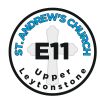History & Architecture
Although the site on which St. Andrew’s is built was given to the Church in 1875, it was some 10 years before any kind of building was erected. Most of the parish stands within the former medieval estate of Wallwood which was purchased in 1817 by William Cotton. A highly successful businessman and governor of the Bank of England, Cotton was one of the most important philanthropists of his day. He was a founder of the National Society, treasurer of the Metropolis Churches Fund and paid the entire building costs of 3 churches in the East End and made substantial donations to over 72 others. He also gave the site on which St. John’s Church stands, and is buried in the graveyard. On Cotton’s death the estate was sold off for development, but his family reserved the site of St. Andrew’s for a church to built in their father’s memory.
During the 1880s the population of Leyton effectively doubled in ten years as more and more houses were built. Against this background it was decided to begin work on what was known as the Cotton Memorial Church. Initially a corrugated iron structure, which stood to the east of the current church building in St Andrew’s Road, was provided. The Rev. William Manning was installed as Vicar and a building fund instigated. The foundation stone was laid on 18 June 1886 by the Duke of Connaught, and in recognition of Cotton’s importance , the Lord Mayor of London and five Bishops were also present.

The church was built in stages to a design by Sir Arthur Bloomfield. The Chancel and first bays of the nave was ready and dedicated in 1887. The elaborate chancel was paid for by William Cotton’s children as a memorial to him and the whole structure is far more elaborate than many other of Bloomfield’s designs. However, quality costs, and the congregation were unable to pay for continued work and building stopped. A remarkable fundraising campaign followed, and in 1893 the principal building was complete. Choir and Clergy vestries were added in 1913.
The Church was immensely fashionable – weekly total congregations in 1903 exceeded 1500 people. Unusually, St. Andrew’s charged no pew rents and there was no endowment. Until the 1920s the clergy were paid entirely by the congregation. Neither was a Vicarage provided (despite local myths to the contrary): the parish rented a house in Chadwick Road for the Vicar until well after the Second World War when the current vicarage was purchased.
In its Edwardian heyday St. Andrew’s also offered day and evening classes for both children and adults, an amateur orchestra, gym , tennis and cricket club. Regular entertainments were a feature, and were held in the ‘Iron Building’ as the former temporary building became known.
Further fundraising resulted in a splendid Arts & Crafts style Church Room being built in 1904 to the design of Henry Smart. Sadly, having been sold to the Leytonstone School in the 1970s, the halls were destroyed by fire and replaced by flats.
St. Andrew’s thrived until the early 1930s when finance again became an increasingly significant issue. Despite large congregations, finding the finance to keep going begins to feature in church council minutes. Following the Second World War this process escalated until in the 1960s closure was discussed as a possible option. The formal decision to close the church was taken in 1967 and events put in hand to wind up parochial affairs in 1968. The appointment of a curate, Rev. Graham Laut, to formally close the parish down was a turning point. Laut became convinced that St. Andrew’s could, and should, have a future. Crucially, the Diocese too were having second thoughts : principally they were not convinced that the existing congregation could be catered for at neighbouring churches. Thus, literally almost at the last hour, St. Andrew’s was reprieved.
It was agreed that the Church Rooms should be sold and the church building itself converted to provide some hall accommodation. This work was carried out in 1977.
Since the 1970s St Andrew’s has moved from strength to strength with increasing congregations and closer engagement with the changing local community. The church is now at the exciting point of being able to consolidate the fabric of this Grade II listed building thanks to significant grants from English Heritage, and to pursue an imaginative and sympathetic scheme to develop the Community Hall section of the building.
